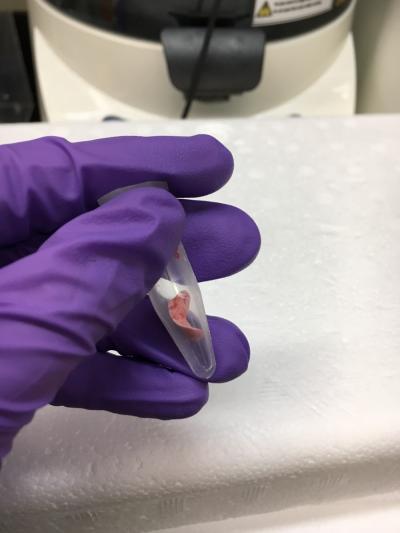Postbac Life: Wading Into Drug Discovery Research
“That machine? You’re gonna have to get up close and personal with it,” Josh, my fellow postbac, told me. I looked at this small metal contraption and nodded, trying to appear as if I understood, while thinking: he just means that people spend so much time sectioning organs on the microtome that it’s like spending an extended amount of time with a loved one, right?
Fast forward a few days, and I find myself breathing warm, moist air onto a paraffin-embedded mouse lung to soften the wax, just before I slice four-micrometer sections of mouse lung tissue that will later be stained and examined under a microscope. “He wasn’t kidding,” I muttered.
Sectioning mouse lung tissue is one of the first techniques that I can proudly say I performed by myself in my lab at NIH, led by IRP senior investigator Dr. George Kunos. In the weeks leading up to my first session with the microtome, I went through a seemingly endless amount of online training for lab safety, animal facilities, cyber security — the list goes on. I appreciated being slowly eased into full-time lab work, although I neurotically took notes while watching those thirty-year-old videotapes-turned-into-digital-videos for fear of failing the quizzes.

Paraffin-embedded mouse lung tissue on a microtome for sectioning. The thin, paper-like sheet is a section of tissue that will later be used for immunohistochemistry to examine thickening and scarring of the lung’s connective tissue, called fibrosis.
I also spent a lot of time shadowing Josh and my lab’s other postbac, Nick, during their daily tasks so I could learn to eventually perform them myself. Before I started training in the IRP, I had feared the monotony of full-time benchwork, since in one of my previous labs I spent over 300 hours in one summer watching mice run on a treadmill or a rotating rod. I was relieved to find that I now had the chance to learn many techniques and work on multiple projects, keeping my day-to-day quite varied and busy.
In the IRP, for the first time, I learned about different drug delivery techniques, including intraperitoneal (injecting a drug into the abdominal cavity) and intratracheal (delivering a drug through the trachea directly into the lung). My research specifically focuses on evaluating treatments for fibrosis, a thickening and scarring of connective tissue that can happen spontaneously or as a result of injury. My fellow postbacs and I have been testing treatments on mouse models of Hermansky-Pudlak Syndrome, a rare disease that causes often-lethal lung fibrosis, as well as animal models of spontaneously developing fibrosis in the lungs and other parts of the body. Nick, Josh, and I work on different parts of the same set of projects to collectively help advance all of them. Nick and Josh currently handle a majority of the mouse work, while I section and stain lungs to examine their structure.

Mouse lung tissue flash-frozen in liquid nitrogen to preserve tissue structure and to store before performing protein expression analysis.
Contrary to how many other labs are run, our lab does not have weekly lab meetings. Resat, a staff scientist in my lab, explained that people report directly to Dr. Kunos, making communication more streamlined. We are noticeably more productive without time spent in lab meetings, although we must make deliberate efforts to speak directly with other lab members to learn about their current projects.
While I have been training in Dr. Kunos’s lab for more than four months already, I feel like I just started yesterday. I still need to ask where certain materials are located, and I sometimes ask Josh or Nick to double-check my work. I am still getting my bearings and often feel uncertain of what to do next, especially since I am learning techniques that were not used in my previous labs. I hate making mistakes, but Resat is very forgiving and helps me learn when something doesn’t go quite right.
After a particularly spectacular over-staining of some slides, Resat explained to me that, even though it might be nice to get the correct stains right off the bat, making mistakes gives me a chance to grow and truly understand the science behind every step of the protocol. It feels like I am getting paid to learn as an IRTA Fellow (instead of when I paid to attend college!), and I am grateful for the opportunity to advance as a scientist during this transitional stage in my post-grad life.
Related Blog Posts
This page was last updated on Monday, January 29, 2024
